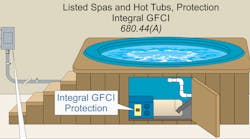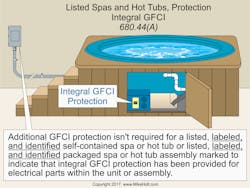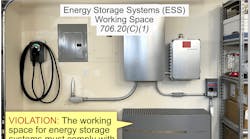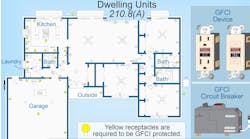Electrical installations for spas, hot tubs, and hydromassage tubs must comply with Part I of NEC Art. 680. The requirements that apply specifically to spas and hot tubs are in Part IV. Those that apply specifically to hydromassage tubs are in Part VII.
Emergency switch
In other than a one-family dwelling, you must supply a clearly labeled emergency shutoff for a spa or hot tub water recirculation and jet system. You can use either the maintenance disconnect [680.13] or a push button that controls a relay.
The emergency shutoff must be readily accessible to users and at least 5 ft away, adjacent to and within sight of the spa or hot tub [680.41] (Fig. 1). This requirement applies to spas and hot tubs whether installed indoors or outdoors.
Outdoor installations
Equipotential bonding of perimeter surfaces per 680.26(B)(2) isn’t required for outdoor spas and hot tubs if the unit is [680.42(B)]:
- Listed, labeled, and identified as a self-contained spa or hot tub for aboveground use (the labeling and identifying requirements are new with the 2017 NEC).
- Not identified as suitable only for indoor use.
- On or above grade.
- The top rim of the spa or hot tub must be located at least 28 in. above all perimeter surfaces located within 30 in. from the unit.
You can use any Chapter 3 wiring method in the interior of a dwelling unit for the connection to a motor disconnect and the motor, heating, and control loads that are part of a self-contained (or packaged) spa or hot tub (newly permitted with the 2017 NEC) [680.42(C)].
Indoor installations
When determining the dimensions for indoor installations [680.43], the distance you measure is the shortest path the cord of an appliance connected to the receptacle would follow without piercing a permanent barrier (e.g., floor, wall, ceiling, window opening, etc.).
Electrical installations for an indoor spa or hot tub must comply with Parts I and II of Art. 680, except as modified by Sec. 680.43. Indoor installations of these must be connected by any of the wiring methods contained in Chapter 3 [680.43].
But the equipotential bonding requirements for perimeter surfaces contained in Sec. 680.26(B)(2) don’t apply to a listed self-contained spa or hot tub installed above an indoor finished floor [680.43 Ex. 2].
At least one 125V, 15A or 20A receptacle on a general-purpose branch circuit must be located between 6 ft and 10 ft from the inside wall of a spa or hot tub [680.43(A)].
Receptacles must be:
- At least 6 ft (measured horizontally) from the inside walls of the spa or hot tub.
- GFCI-protected if rated 125V, 30A or less and within 10 ft of the inside walls of a spa or hot tub.
- GFCI-protected if they provide power for a spa or hot tub.
Locate any switches at least 5 ft, measured horizontally from the inside walls of the spa or hot tub [680.43(C)].
The following metal parts of an indoor spa or hot tub must be bonded together [680.43(D)]:
- Fittings within or attached to the indoor spa or hot tub structure.
- Parts of electrical equipment associated with the indoor spa or hot tub water circulating system unless part of a listed self-contained spa or hot tub.
- Surfaces, raceways, and piping within 5 ft of the inside walls of the indoor spa or hot tub, and not separated from the indoor spa or hot tub by a permanent barrier.
You don’t need to bond nonelectrical equipment, such as towel bars or mirror frames, which aren’t connected to metallic piping. Where you do bond, however, you must use one of these methods [680.43(E)]:
- Interconnection of threaded metal piping and fittings.
- Metal-to-metal mounting to a common frame or base.
- A solid copper bonding jumper; insulated, covered, or bare, not smaller than 8 AWG.
Self-contained spa and hot tub GFCIs
A self-contained spa or hot tub is a factory-fabricated unit that consists of a spa or hot tub vessel with water circulating, heating, and control equipment integral to the unit. A packaged spa or hot tub equipment assembly is a factory-fabricated unit that consists of water circulating, heating, and control equipment mounted on a common base intended to operate a spa or hot tub [680.2].
Any outlet supplying either one of these or a field-assembled spa or hot tub must be GFCI protected [680.44].
Because this rule applies to all outlets and not just receptacle outlets, a hard-wired indoor spa or hot tub requires GFCI protection.
Additional GFCI protection isn’t required for a:
- Listed, labeled, and identified self-contained spa or hot tub unit (or assembly) marked to indicate that integral GFCI protection has been provided for electrical parts within the unit or assembly (Fig. 2).
- Field-assembled spa or hot tub rated 3-phase with a voltage rating more than 250V, or with a heater load above 50A.
Hydromassage bathtubs
A hydromassage bathtub is a permanently installed bathtub with a recirculating piping system designed to accept, circulate, and discharge water after each use [680.2]. It must comply with the requirements of Part VII but not with the other parts of Art. 680 other than Part I [680.1, 680.71].
The NEC treats a hydromassage bathtub like a regular bathtub, not like a pool. Thus, switches and receptacles have no minimum distance requirement (Fig. 3).
Hydromassage bathtubs and their associated electrical components must be on an individual branch circuit protected by a readily accessible GFCI [680.71].
GFCI protection is also required for receptacles rated 30A (or less) at 125V if located within 6 ft of the inside walls of a hydromassage bathtub.
The circuit for a hydromassage bathtub must be installed per the manufacturer’s instructions included in the listing and labeling; it will typically include amperage requirements and may require separate circuits for the pump and heater [110.3(B)].
Luminaires, switches, receptacles, and other electrical equipment located in the same room and not directly associated with a hydromassage bathtub must be installed per Chapters 1 through 4 [680.72].
Electrical equipment for hydromassage bathtubs must be capable of being removed or exposed without damage to the building structure or finish [680.73]. Where the hydromassage bathtub is cord-and-plug connected and the supply receptacle is accessible only through a service access opening, that receptacle must be installed within 1 ft of the opening with its face in direct view.
The 2017 NEC has a new bonding requirement — the following metal parts must be bonded together [680.74(A)]:
- Fittings within (or attached to) the hydromassage tub structure and in contact with the circulating water.
- Parts of electrical equipment associated with the hydromassage tub water circulating system, including pump and blower motors.
- Cables (if metal sheathed), raceways, and piping within 5 ft of the inside walls of the hydromassage tub and not separated from the tub area by a permanent barrier.
- Exposed surfaces within 5 ft of the inside walls of the hydromassage tub and not separated from the tub by a permanent barrier.
You must also bond electrical devices not associated with the hydromassage tubs if they are within 5 ft of the hydromassage tub. Two exceptions:
- Small conductive surfaces not likely to become energized, such as air and water jets, supply valve assemblies, and drain fittings not connected to metallic piping, and towel bars, mirror frames, and similar nonelectrical equipment not connected to metal framing don’t need to be bonded.
- Double-insulated motors and blowers.
When installing the required bonds, use a solid copper conductor at least 8 AWG. The bonding jumper doesn’t have to be extended (or attached) to any remote panelboard, service equipment, or electrode [680.74(B)].
When a double-insulated circulating pump or blower motor is used, you must provide a bonding jumper long enough to terminate on a replacement of same. In addition, it must terminate to the equipment grounding conductor of the branch circuit of the motor.
Zero potential
Most of the requirements for these installations have to do with bonding. Bonding metallic objects eliminates a significant source of shock hazard. When metallic objects are at zero potential with each other and the water, no current can flow to endanger the person in the pool or tub.
It’s possible you will encounter something that is not explicitly required to be bonded and not explicitly exempt from bonding. So do you bond it? If, in your assessment, there is a chance current can flow from that object to the pool or tub user, then you already know the answer to this question.
Holt is the owner of Mike Holt Enterprises, Inc. in Leesburg, Fla. He can be reached at www.mikeholt.com.







